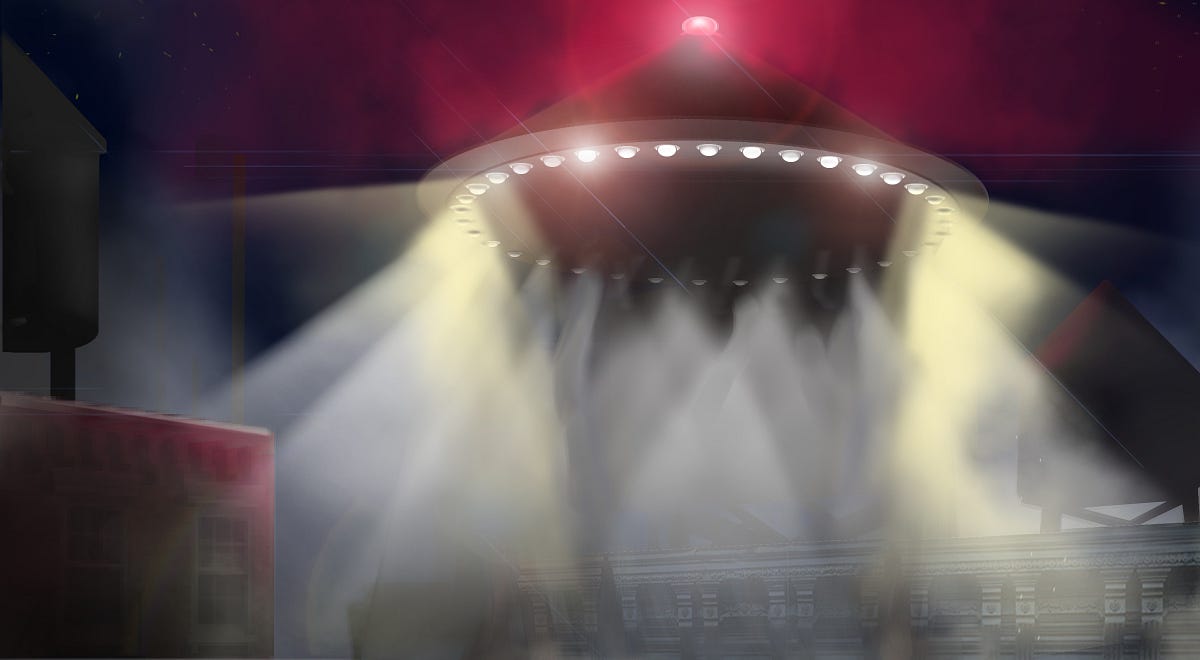Analysis & Commentary
One hot August night in 1974, John Lennon and May Pang claimed they saw a UFO in New York City. What say you?
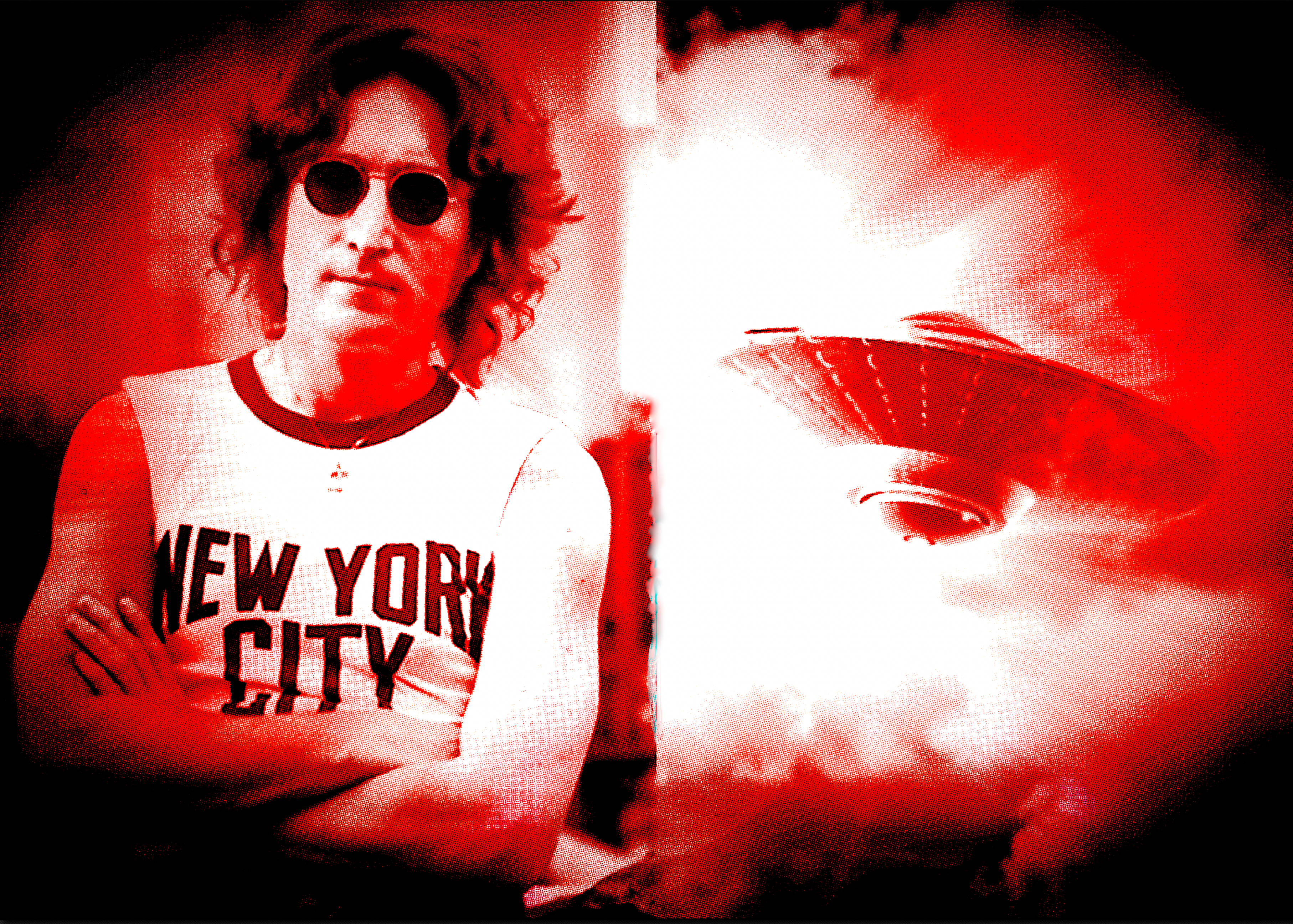
It Was 46 Years Ago Today
In the last days of August in the summer of 1974 — August 23rd, exactly — John Lennon and his secretary girlfriend May Pang said they saw a UFO outside their rented 52nd Street penthouse apartment.
Lennon put this claim in the liner notes of his upcoming Walls and Bridges album. He released a sketch he’d made immediately after the event. He granted interviews. And shortly before his death in 1980, he recorded a song lyric that said that there were UFOs over New York. He talked directly and publicly about the subject on multiple occasions. Privately, he told an even more personal story that proves to be a Rorschach Test about how you see John Lennon.
There’s been only a smattering of actual reporting about the August 23rd encounter, or even the broader Lennon/UFO connection. People tend to dismiss his sighting because there are so many other great cases and the obvious problem, Hey, it’s a John Lennon UFO story, right?
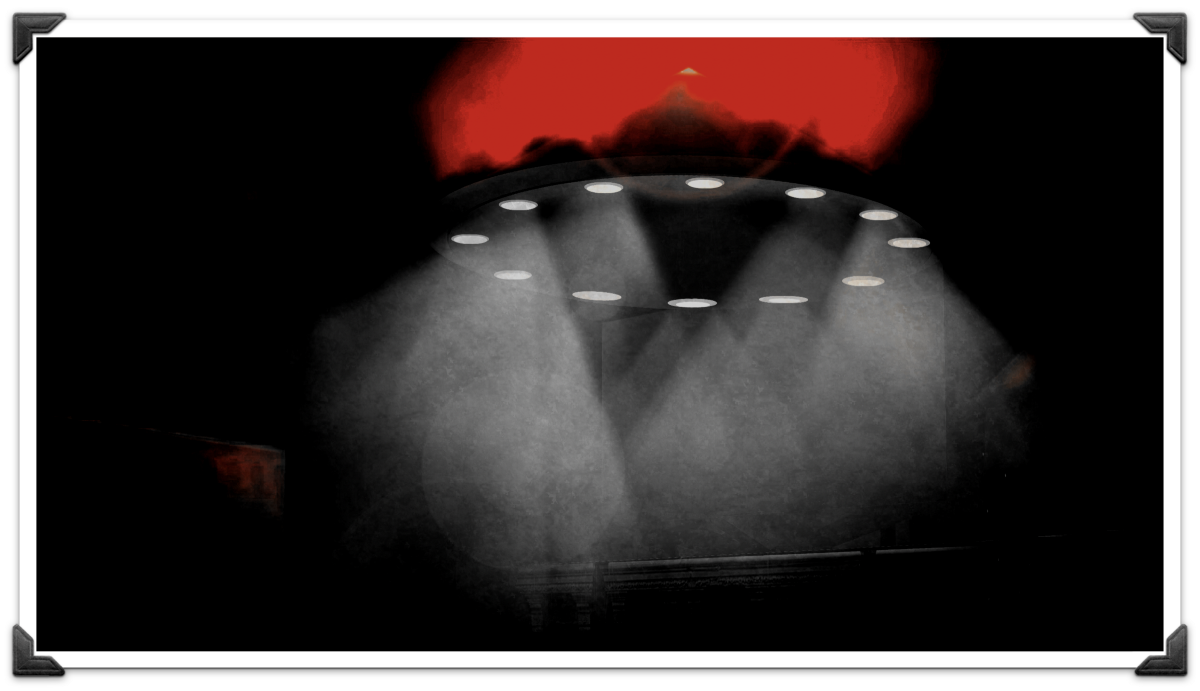
“I was standing, naked, by this window leading on to that roof… just dreaming around in my usual poetic frame of mind… as I turned my head, hovering over the next building, no more than a hundred feet away was this thing with ordinary electric light bulbs flashing on and off round the bottom, one non-blinking red light on top. It was coasting, very quietly, like a tourist! So I just watched. After about twenty minutes it disappeared over the East River and behind the United Nations building.”
— John Lennon

“As I walked out onto the terrace, my eye caught this large, circular object coming towards us. It was shaped like a flattened cone, and on top was a large, brilliant red light, not pulsating as on any of the aircraft we’d see heading for a landing at Newark Airport. When it came a little closer, we could make out a row or circle of white lights that ran around the entire rim of the craft — these were also flashing on and off. There were so many of these lights that it was dazzling to the mind.”
— May Pang
If it’s a true story, then John Lennon’s sighting provides real data about the extreme strangeness of the craft he described, the duration of encounter, and the debate about physical reality of objects versus a psychic reality. If something really happened to John Lennon and May Pang then, whatever that was, real or other-real, it’s worth our time.
Skeptics diminish it as just a story told by the stoned leader of a popular music group from a time long ago. Maybe Lennon cooked the whole thing up on a lark as a piece of performance art. If that’s true, the story loses its reason for being, and it makes us like Lennon less.
So there are real stakes in making up our minds about this one.
The calendar now stands at the eve of what would have been his 80th birthday (on October 9, 2020) followed by the 40th anniversary of his murder (December 8, 2020).
Even in death, Lennon’s public belief in this story challenges us to hear him out, and start to make our final judgment.
Summer of ‘74
John Lennon’s UFO sighting happened in New York City on Friday night, August 23, 1974 at 9:00 p.m. and was witnessed and confirmed by May Pang.
1974 through 1978 were active years for UFO sightings, but 1974 started the run by turning out to be a showbiz year for the the phenomenon. John Lennon was not the only super celebrity to see an unidentified flying object that summer. Then former actor and current California Governor Ronald Reagan not only saw a UFO in those months, but he and his pilot Bull Paynter chased it in their Cessna Citation. The far-left Lennon and the far-right Reagan had something in common after all — UFOs.
Context is everything, particularly in a UFO sighting of this cultural importance. The actual moment of contact with the potentially paranormal might be brief, and a judgment can come down to assessing the quality of a witness. That means understanding their state of mind, no small matter in the case of John Lennon.
Imagine This
August 23rd was exactly two weeks to the day since Richard Nixon had resigned his presidency in disgrace. Newly sworn in President Gerald Ford was still learning how to make his own toast in the family quarters of the White House, and that was big news.
In this brief window of time, there was reason to hope again in America. The stranglehold that Richard Nixon had on our national psyche had been broken. The system actually did look like it had worked and let us throw the bum out. Lennon had his fingers crossed that this could help him on his now raging immigration case. Even Vietnam was winding down.
Americans were looking for a return to a little bit of innocence after the 1960s, and many had discovered a new show called Happy Days. It even appealed to John’s sense of nostalgia for the days of early rock and roll, and gave him something to do on Tuesday nights.
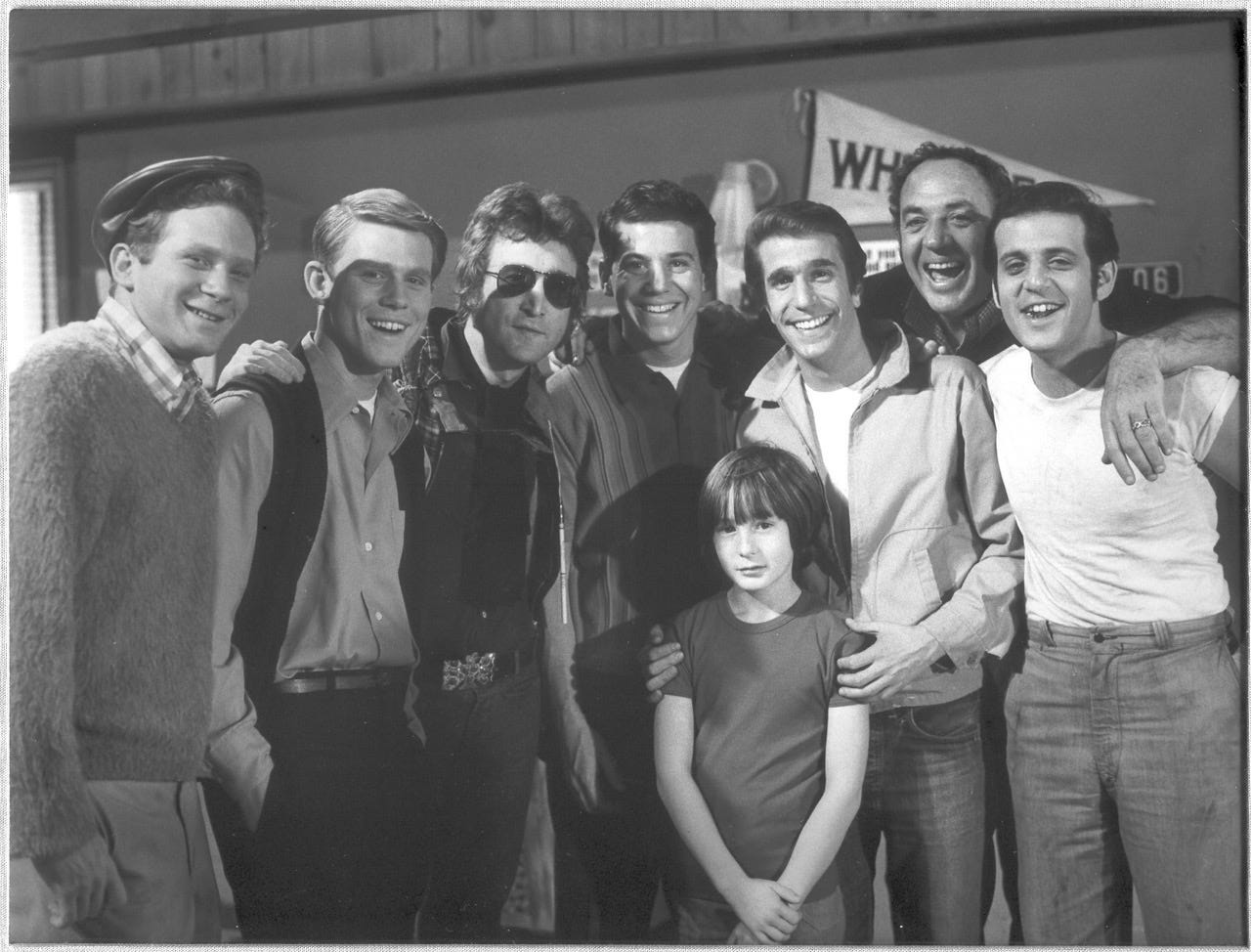
So when Julian was staying with him for a few weeks during Lennon’s L.A. tenure, John not only took his shy son to Disneyland but got them invited to the Happy Days production set. This gave Julian a chance to do something wonderful — meet a true American celebrity like the Fonz. And his wingmen Richie, Ralph and Potsie and the two guys on the end.
This is how strange things had gotten in the mid-70s when the revolutionary Beatle would hang out on the least revolutionary TV show on-the-air and it was cool.
On the A.M. radio stations, Paul Anka had the number one song in America with “(You’re) Having My Baby.” Lennon would have his own Billboard number one a few months later with his party-on song, “Whatever Gets You Through the Night,” recorded with Elton John.
The Lost Weekend Couple
John Lennon and Yoko Ono broke up in the spring of 1973 but never quite cut the chord.
Incredibly, in the beginning, Ono had sent their loyal 22-year-old assistant May Pang to take care of John during their separation. The often insecure Lennon immediately turned Pang into his lover as he also hit a low point of drug and alcohol abuse. May became an eyewitness to a series of embarrassing and spirit-crushing public run-ins about town.
There was no getting around how strange this triangle of relationships was. Lennon lived with Pang in an affair set up by Ono who never stopped wanting to hear what Lennon and Pang were up to. Lennon and Ono often spoke multiple times per day. Pang endured and tried to do the job Ono gave her — keep John Lennon safe.

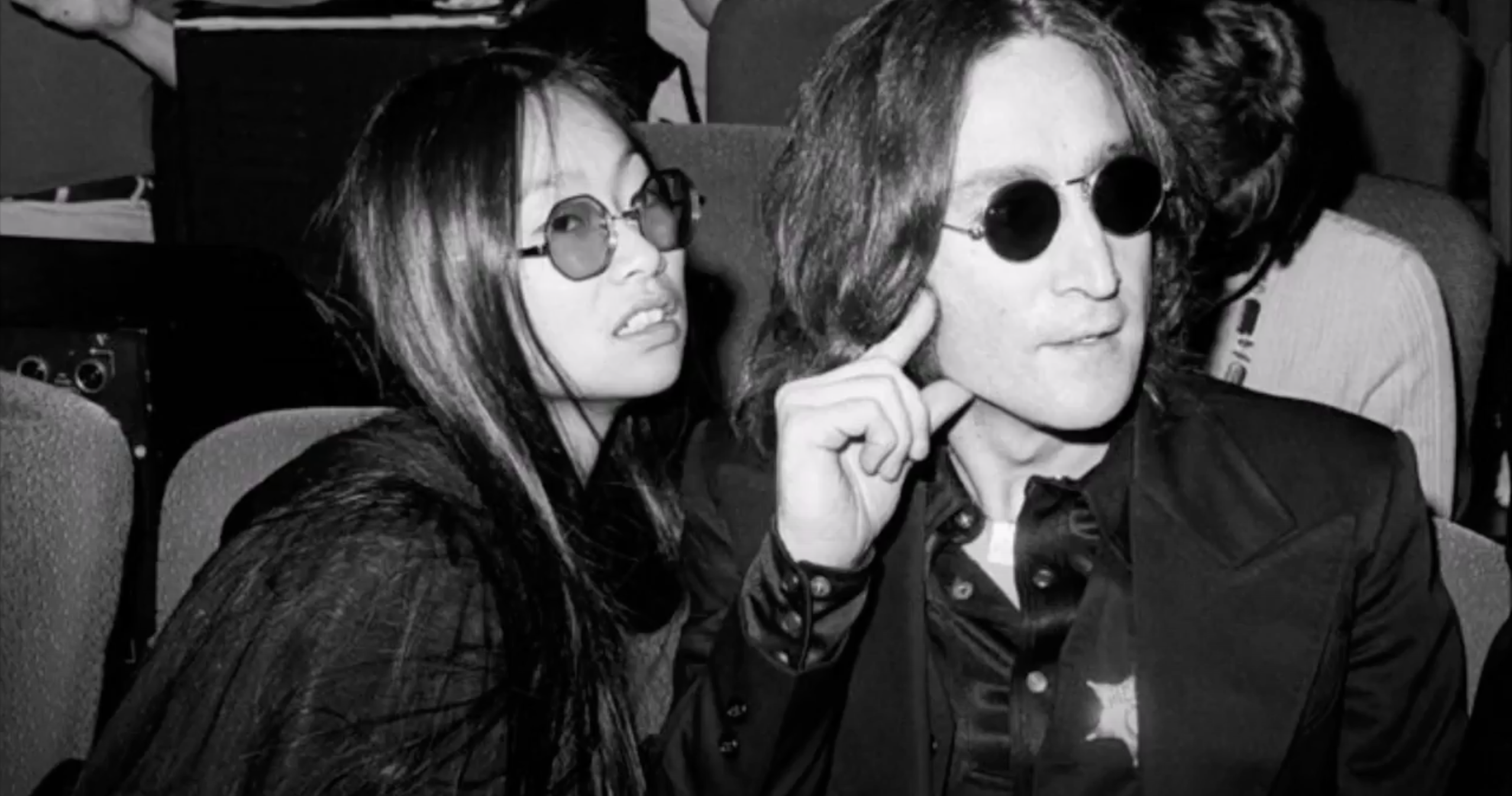

With May Pang by his side in June 1974, John had just lived through more than a year of his “Lost Weekend” in Los Angeles. It had not been an easy situation so when John suggested going back to New York to help Harry Nilsson finish his Pussy Cats album, Pang agreed, even though she knew that only put John within walking distance of Yoko.
John and May fled his dissolute LA lifestyle for a fresh start and moved into a penthouse apartment on East 52nd Street, just a building away from the East River. It was a great apartment with a view of Brooklyn’s Navy shipyard docks. Lennon told friends that whenever he looked out it reminded him of working-class Liverpool where he grew up with the other Beatles.
A Night to Remember
It was a Friday night and Lennon and Pang were in for the evening.
John wanted to listen to the studio output on Walls and Bridges and get his notes together. He had watched last year as McCartney crushed it with Band on the Run, and Lennon wanted to have some of that, too.
Plus, the day had been muggy and awful, 82 degrees with 85 percent humidity. Pang had said that it was so oppressive and heavy that “you could cut it with a knife.” For John, the idea of kicking off his clothes and chilling on his bed seemed like a good option.
Around 8:00 p.m., the temperature had dropped to just 72 degrees. May turned off the AC and threw open the windows. Maybe there would be a breeze coming off the East River.
As it turns out, more than a breeze was on the way.
Man Under Pressure
John was feeling more paranoid than usual these days and with good reason.
First Lennon and Yoko Ono, and now Lennon and Pang, believed their phones were tapped. They felt that when they went outside on the streets of New York or Los Angeles that they were being followed.
Because of his outspoken radical left talk and actions, when Lennon came to the United States in September 1971, officials high up in the CIA and FBI feared that Lennon really could start a revolution and the thought disgusted them. Lennon and Ono were almost immediately put under surveillance.
Then, on March 23, 1973, John Lennon was issued an order by U.S. immigration authorities to leave the United States, and given 60 days to do so. He armed up with a lawyer and fought to stay in America under a legal cloud that hung heavy in the days of his UFO sighting.
This paranoid reality may have contributed to Lennon and Pang being home on a summer’s Friday night ordering pizza delivery.
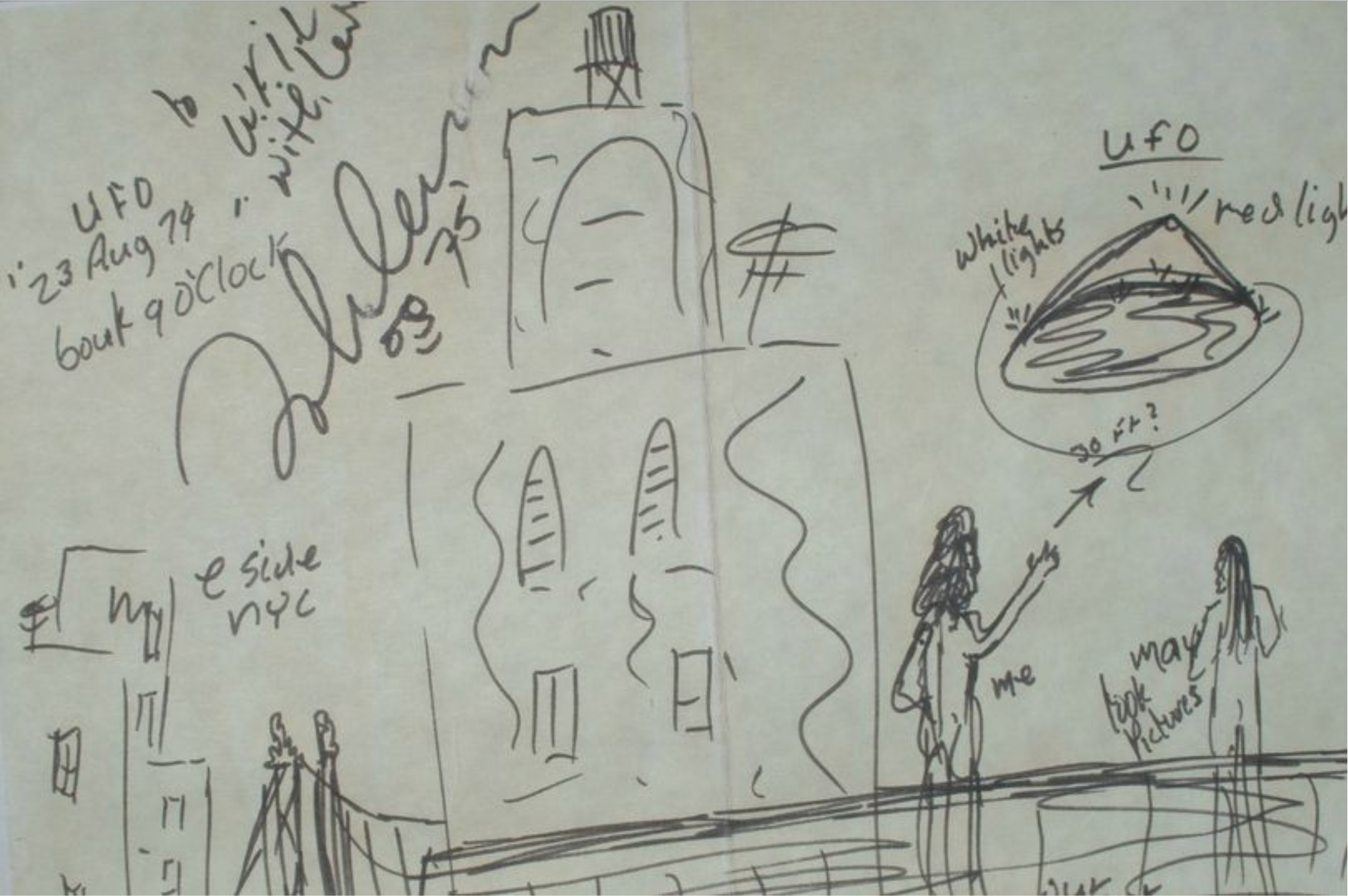
Hot August Night
Lennon’s 52nd Street apartment had a view. Only a few feet off the living room, through a window, you could be on the building’s roof which became a deck, and Lennon felt it was private the way he liked it. Plus, the view was stellar from inside and out.
May Pang decided around 8:30 p.m. that she’d get a shower and order up a pizza delivery for later. John was okay with that because he said he had to review ideas being pitched for his new album’s cover. In the end, he used a painting he’d done as eleven year old.
John Lennon insisted throughout his life that he was “very straight” at the time he saw a UFO. Lennon had experimented with most drugs and abused a few. Not, however, on August 23rd, 1974, according to John. When his biographer Ray Coleman asked him if he’d been smoking or drinking, he replied, “No, God’s honest truth. I only do that at weekends or when I see Harry Nilsson.”
For her part, May Pang was considered the “stable one” among their mutual friends. She didn’t drink or take drugs. Her worst vice was going through countless bottles of Coca Cola every day.
Lennon would describe what happened next numerous times over the years to friends, TV crews, radio DJs. The story beats always laid out the same way.
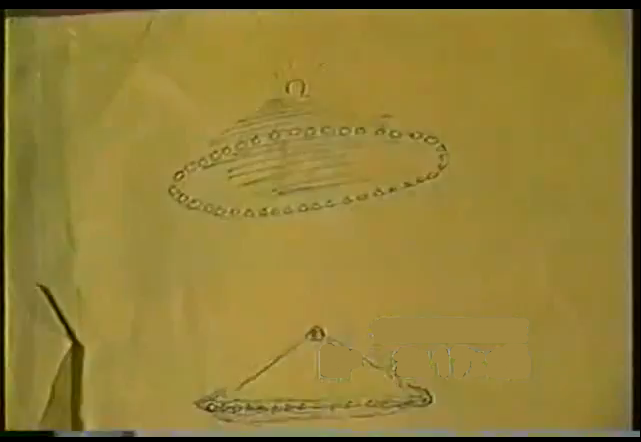
He was lying naked on his bed when he got the urge to go to the window. Outside, he saw, no more than 100 yards (or feet, in a different telling) away, a craft of some kind with ordinary looking electric light bulbs flashing on and off on the bottom and one non-blinking red light on the top.
He said the UFO was first seen just south of the building. It was brightly lit, hovering silently over an adjacent building so close he would say he could have hit it with a brick. Pang described it as the size of a Lear jet.
As John Lennon would later describe, “I wasn’t surprised to see the UFO really, as it looked just like the spaceships we’ve all seen on the cinema growing up, but then I realized this thing was real and so close, that I could almost touch it.” Again, for context, no one would really see these light-show type UFOs on a theatrical screen for three more years with the release then of Steven Spielberg’s Close Encounters of the Third Kind.

As May was drying off from her shower, she heard John yell from the outside roof, “May, come here right now!” When she didn’t come immediately, she heard, “Now!” With no time to dress herself, she ran to the observation deck, naked, only to find Lennon, also completely nude. She wasn’t surprised. He had been clothing optional as long as she knew him.
Ordinarily, this might be a funny moment, except that Lennon was pointing wildly at the southeastern sky. The watched together as the object flew below the tops of the higher buildings. He made clear in interviews that if somebody had been on a higher building, they would have looked down on it.
“There’s a whole list of rational things I went through. A helicopter, not a helicopter, balloon, not a balloon, it’s too close to the roof and it’s maneuvering!.. It’s gotta be from lights on billboards, but we don’t have any billboards around here…”
Pang provided other details over the years that are striking, particularly ufologically. She saw it going towards Brooklyn and wanted to call friends who lived there and tell them to look for it. There’s an oddly specific reference to seeing it hover over a building on 23rd Street, a long ways from their penthouse.
“We often had helicopters flying above us, but this was as silent as the night, seventeen stories up above street level.”
At the beginning, they felt that it was “two to three stories above our heads.” It took a long time coming down. Toward the end of the craft’s journey up the East River, she described it as slowly climbing, and then speeding straight up and — poof — gone.
Additionally, Pang has told a detail that gives her overall story more credibility because of its extreme strangeness, and the fact that it is unusual.
“It went sideways at one point. I thought, ‘It’s sideways!’”
This sideways description is a common trait ascribed to UFO behavior. It is not, however, the first thing a trickster imagines saying about a sighting they are making up.
Finally, she thought to herself that Reggie Jackson, the great baseball hitter of the time, “If he can hit a home run, then he could hit this thing.”
When they got a better look, she described the bottom as emitting the blurry kind of heat waves that come off a car engine on a hot day. There was a “shimmer” underneath the thing.
May Pang said that the craft’s lighting package blew them away, as it would change configuration every rotation.
The silence of the craft caught them off guard. The object made no sound. None.
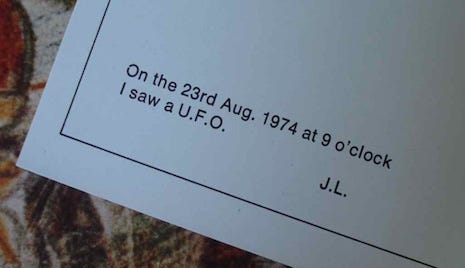
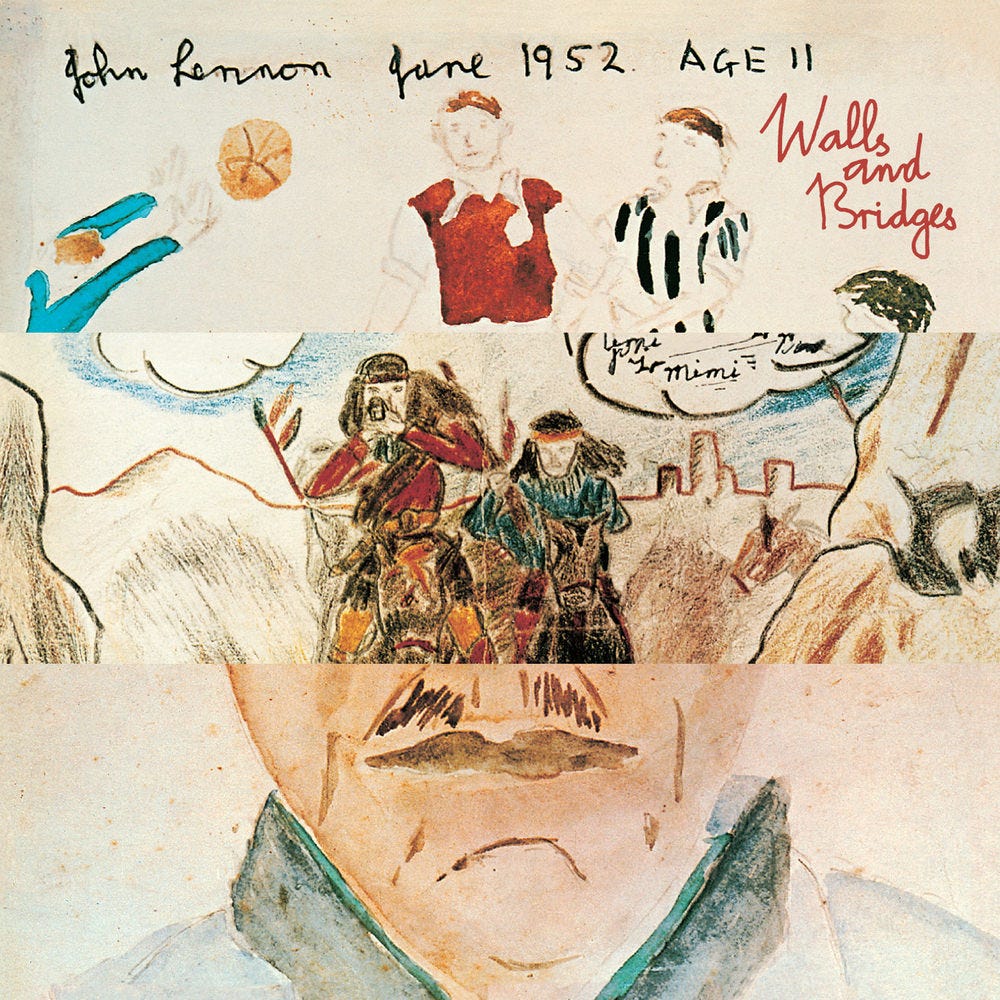
On the Record
Walls and Bridges
The first time fans ever heard about Lennon’s sighting was the fall of 1974 when the new John Lennon album, Walls and Bridges, was released. There, in the liner notes (seen above), Lennon first told us about his sighting.
“On the 23rd Aug. 1974 at 9 o’clock I saw a U.F.O. J.L.”
Inside the album, Lennon gave his buyers a chance to see a panorama, in Lennonesque doodle format, that was some version of his version of events although it’s unclear why he drew a crowd when what he and Pang got appeared to be a private showing.
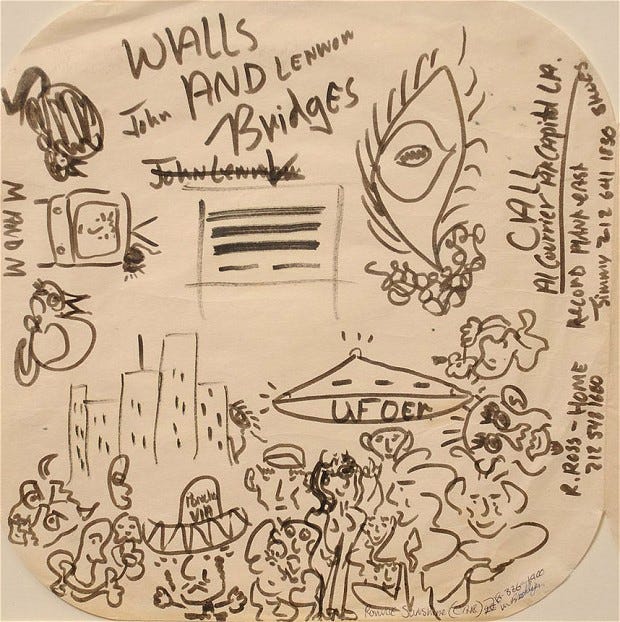
Mind Games
John Lennon actually first put UFOs in a 1973 song, “Out the Blue,” recorded a full year before he claimed his own sighting. It comes at the end and seems to imply that John thought being found by a UFO would be a good thing.
“Like a UFO you came to me, and blew away life’s misery…”
— “Out the Blue,” Mind Games
Milk and Honey
In late 1980, one of the songs Lennon was working on at the time of his death was “Nobody Told Me” from the album that would be released four years later, in 1984, as Milk and Honey. In the song, Lennon sings:
“There’s UFOs over New York and I ain’t too surprised …”
— “Nobody Told Me,” Milk and Honey
“Nobody Told Me” has tremendous new resonance in today’s world of pandemic, protest and partisanship. Consider that he recorded this prescient song shortly before his death. Consider something else:
UFOs were on his mind even at the end.
The Lennon/Pang UFO: An Interpretation
For this article, we commissioned graphic design artist Harrington V Skorupka to show us his interpretation as gleaned from the description of the witnesses. Here he shares the steps on the way to a final product.

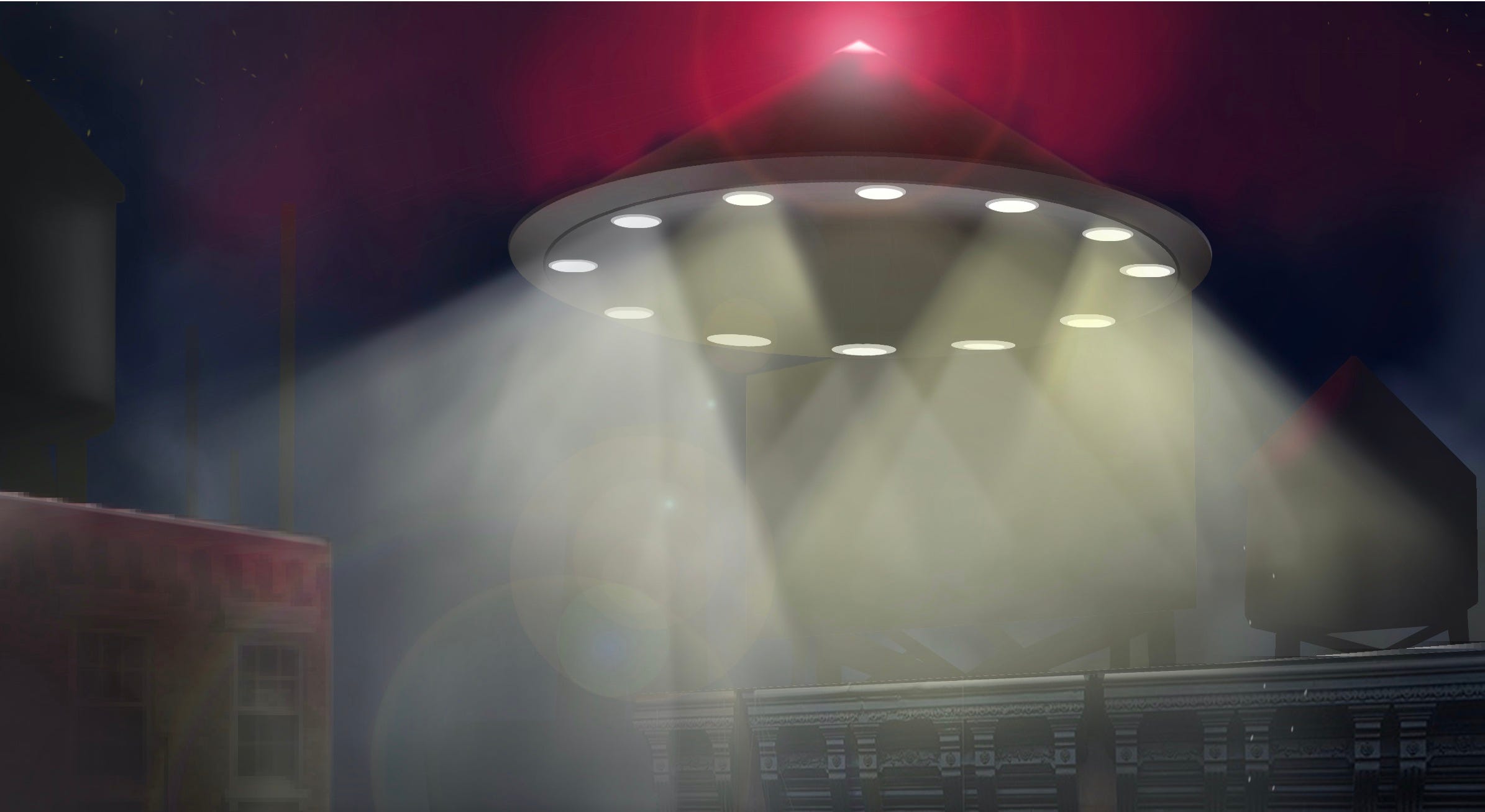
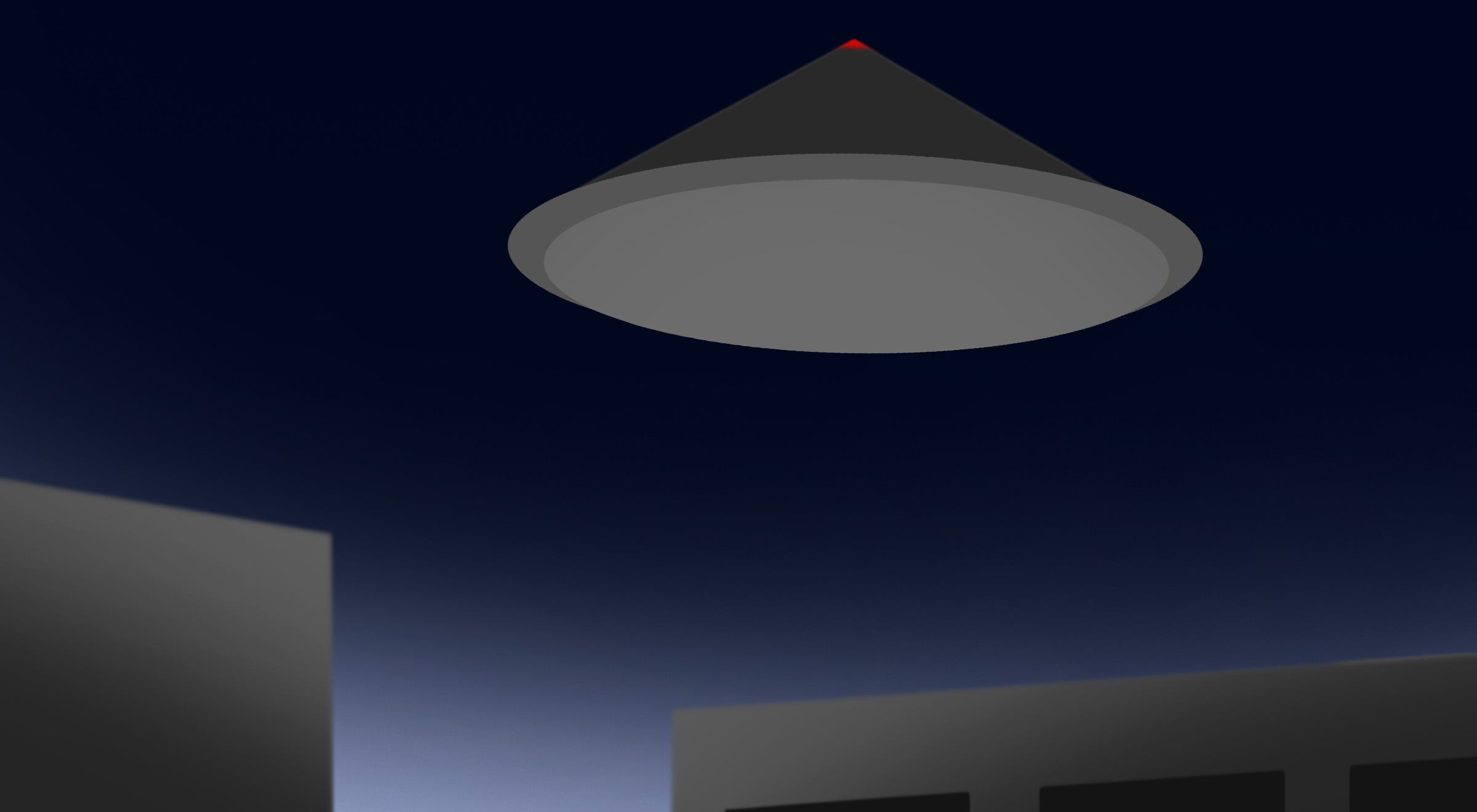

The Departure Lounge
“It was about the size of a Lear jet and it was so close that if we had something to throw at it, we probably would have hit it quite easily.”
Lennon has described the encounter as going on five or ten minutes. Pang would eventually settle on describing the length of time as ten to fifteen minutes. Settle on ten.
That is an extraordinary amount of quality viewing time. They are watching an unidentified flying object that features white lights around the rim of the circular craft that has a red light at the top. It appears to have been a cone shaped, featuring a flat bottom which rises to a pointed top. It can maneuver and hover. It’s completely silent. And they get to watch it for ten close-up, uninterrupted minutes.
They witnessed this bizarre flying craft quietly make a pass by of the United Nations building. Lennon said it slowly veered left, crossed over the East River, then over Brooklyn.
“The lighting on the thing left us awe-struck,” May has said. “As it would change its configuration with every rotation.”
The actual physical structure of the craft was allegedly visible for the entire time they watched it go. She could see the object backlit by the sun’s dying rays.
Its image blended in with the lights of the heavy commercial air traffic found over southern Long Island. Finally, up, and gone.
Where were all the other people of New York City in that time period? In the building that Lennon and Pang resided in, not one apartment she could see was lit up with people home. When asked about it later, Pang said, “We’re talking summer, Friday night. Everybody’s out at the Hampton’s.”
That would be the movie ending way to finish the story, a UFO fading into the sunset while the neighbors have gone to their beach houses. Did we mention this is a story about John Lennon?
Wait for Me
As it started to head away from them, John Lennon called for the UFO to come back and take him away to wherever it was going. Lennon said his biographer Ray Coleman. “They all think I’m potty, but it’s true…”
“I shouted after it, ‘Wait for me, wait for me!’”
“He was very serious and I believe he really wanted that thing to take him with it back to wherever it came from,” explains May Pang, “but then that was John Lennon, always looking for the next big adventure.”
It’s one of those gnarly details in the story that won’t get in line, in later interviews Pang tries to distance herself from Lennon shouting at a UFO to take him away: “He didn’t call out to it,” she corrected. “He later said he wished it had taken us with it. However, I doubt we’d have been that enthusiastic to go along had the opportunity actually presented itself.”
In any case, with the disappearance of the UFO, John and May must have climbed back into their apartment through the window. For the rest of the night, into the next morning, Lennon, never a man at a loss for words, was said to have repeated the same words over and over, like a mantra.
“I can’t believe it… I can’t believe it… I’ve seen a flying saucer!”
John’s first call was to rock photographer Bob Gruen. Lennon demanded that his friend drop everything and get over there fast. He wanted to waste no time in getting the film developed. As he and May waited, John began drawing from his fresh memories that he must have corroborated with Pang’s input at the time.
Sketchy Details
Lennon was a visual artist as much as a musical one. As such, the first thing he set out to do after seeing the UFO was to draw it. He used the material available to him — in this case, a large manila envelope that May Pang happened to get her hands on.
Whether this is similar to what other alleged witnesses had reported is unknown. None have come forward in the public sphere to discuss it, as best as can be determined.
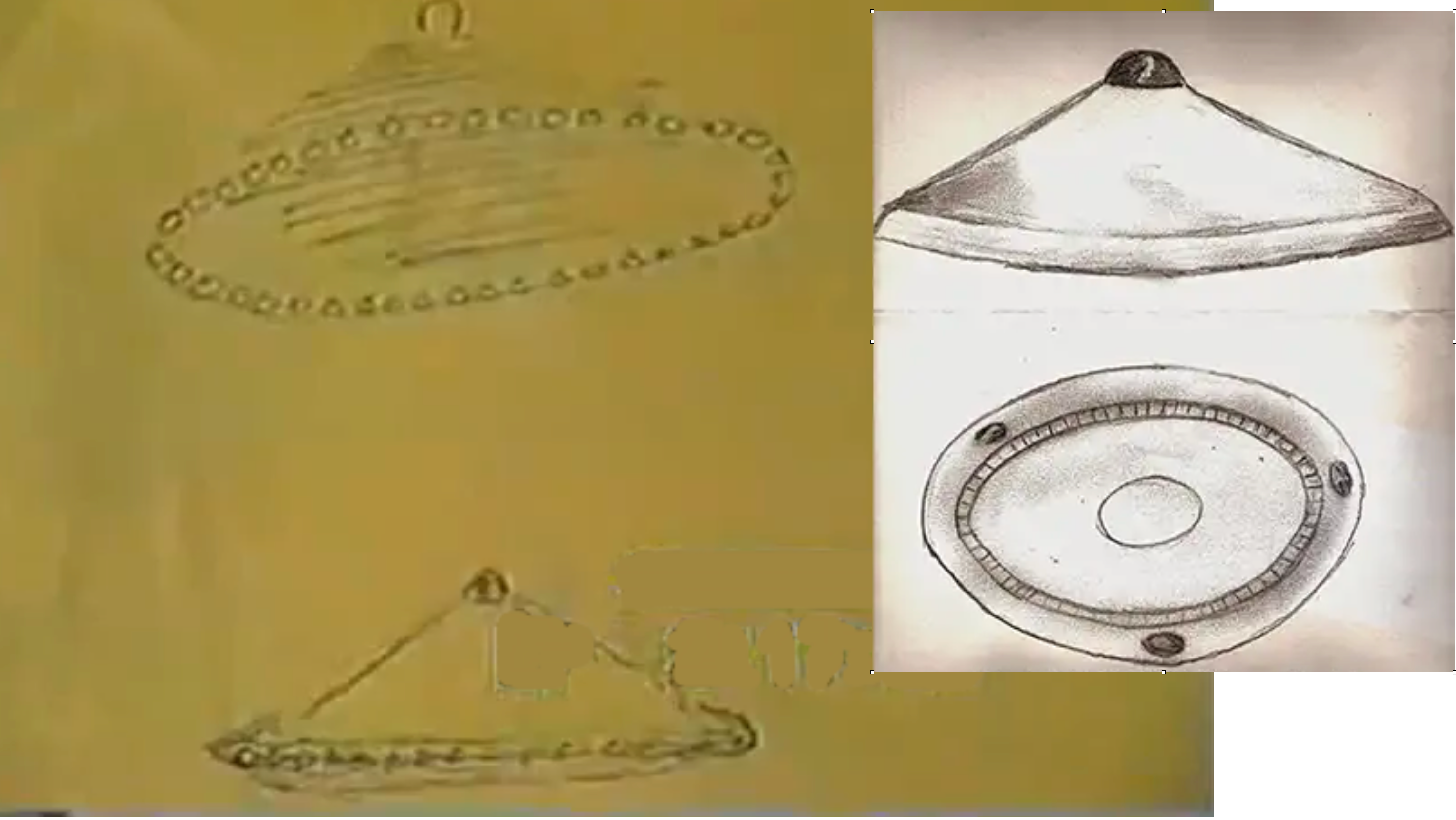
What is very interesting, however, is that the New York City UFO seen by John and May is quite similar to the craft described in the 1966 Westall sighting that is Australia’s most famous case and involved hundreds of witnesses, many of whom were school children.
The Parable of the Photos
The encounter lasted long enough that they had time to get the presence of mind to take pictures. May ran back into the apartment and grabbed her 35mm camera. She used it to take literally many thousands of photos of first-hand events during the “Lost Weekend.” It was a work horse piece of equipment.
Lennon was in his heavy Polaroid phase still, but talked about that instant camera being busted in Andy Warhol’s Interview, “We tried to take pictures (shit on my Polaroid, it was bust) with a straight camera.”
May returned to the roof and she and John took numerous pictures of the craft. “I could have seen it even without my glasses,” bragged John in an interview, “and I’m very short-sighted.” Given how close they describe it as being, this should have yielded some excellent evidence. They had a working camera and a roll of film.
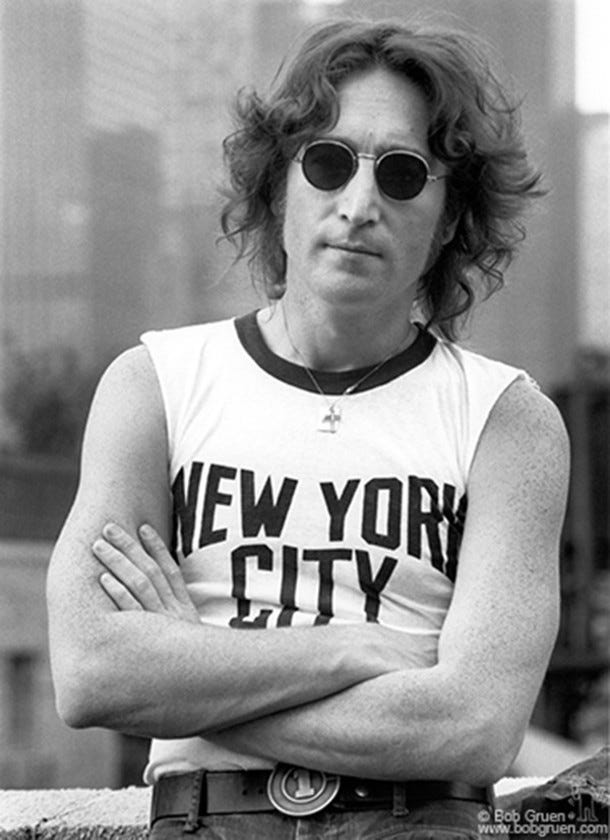
Enter Bob Gruen. He’s he professional photographer who, less than a week later, will take the incredible John Lennon in a New York City ripped tee-shirt photo. Things were moving fast in this world.
On the night of the sighting, however, Gruen arrived and John and May told him what they’d seen, gave him the one roll of 35mm film and tasked him with getting the images developed fast.
“I took the film home and put John’s roll between two rolls of film I’d taken earlier that day and developed them,” said Gruen before taking the air out of the balloon. “My two rolls of film came out perfectly but John’s roll was blank.”
“We gave the film to Bob Gruen to develop,” said Lennon. “He brought back a blank film, said it looked like it had been through the radar at customs.”
Why that was the case has never been convincingly described. Was it a bad film roll out of the hundreds that Pang must have shot in her time with Lennon? Was there something in the air, from the craft itself, that destroyed the film through a technological means? What happened to that film roll after Gruen said it was blank? If it still exists, can it be tested with new technology?
All of John’s line drawings are wonderful to have and are a snapshot of his state of mind. Nothing would have bolstered his story more than a single photograph, good or even bad, of something.
After calling Bob Gruen, John’s next call was to Yoko Ono at the Dakota apartment to tell her what he’d seen. As May Pang remembers it, Yoko was unhappy that she hadn’t seen it, too, and felt that he had “left her out of all the excitement.”
Looking for Other Witnesses
Finding a corroborative witness should have happened but didn’t. We get a mostly consistent feeling from the differing accounts that efforts were made to reach out to authorities and that the consensus was that others had reported the same kind of thing at the same time.
Gruen figures in this quest prominently, given his arrival there to get the roll of film and see that it was developed ASAP. Although it’s unclear if he got involved in the action Friday night or Saturday morning, most accounts say he’s the one who called up the local police precinct.
Why, if it was so important, wouldn’t Lennon make the call himself? “I’m not going to call up the newspaper and say, ‘This is John Lennon and I saw a flying saucer last night.’”
Gruen questioned an officer about whether anyone had reported a UFO or flying saucer. The police response, supposedly, was, “Where? Up on the East Side? You’re the third call on it.”
Gruen’s second call was to the Daily News to see if they’d heard about anything going down on the East Side. Between five and seven other calls was the answer.
Gruen’s next call was to The New York Times. As the story goes, and it might just be apocryphal, the reporter hung up on him.
Lennon boiled it all down to this: “We even called the police — that’s how excited we were — and they told us to keep calm, that others had seen it too.”

Following his UFO bonding, Gruen’s iconic “New York City” photo would debut in the November 1974 issue of Andy Warhol’s Interview magazine. In it, John Lennon gets interviewed by Dr. Winston O’Boogie, one of Lennon’s aliases. Lennon made sure to ask himself about his UFO experience in his self-interview, trying to inoculate himself against people who would feel he must have been stoned out of his mind. “Actually,” he swears, “I was very straight.”
“All the time it was there, I never took my eyes off it. My friend came running and bore witness with me. Nobody else was around. Well, it stayed around for a bit, then sailed off.”
An Unreliable Witness
The term “unreliable witness” is a term of art out here in Hollywood to refer to a character in a film or TV series who can’t be relied on to tell the truth because of a character flaw or a compelling reason to lie. There are four reasons people like to dismiss John Lennon as a credible UFO witness:
- He believed in UFOs before he saw one.
John Lennon thought about UFOs as a kid. He talked about them as an adult. Skeptics immediately jump on this kind of thing, wagging fingers that this is proof that he must have made it up because he already knew about UFOs! - He had a substance abuse problem.
John Lennon had abused drugs for most of his life. Alcohol, marijuana, heroin, LSD, cocaine and others. Prior to the sighting, in LA, he’d been a liquored-up party boy, but having just returned to New York he was, by most accounts, clean and sober. - He loved to be part of a public spectacle.
Is it possible that Lennon cared so much about UFOs that he invented a story about seeing one as a kind of performance art, something he had learned from his years living with Yoko Ono, a performance artist? Don’t just have an opinion about UFOs, see one yourself. More dramatic. - He was nude when it happened.
The coverage of the case has been minimal, voyeuristic in its celebrity focus, and limited to recycling the same quotes, rather than pulling together the larger picture of what the witnesses said happened. The click-bait articles have space to say that both Lennon and Pang were nude.
Admittedly, Lennon is not the first person you’d want to believe if he’s telling a story that sounds impossible. A UFO-believing drug-taking show-offing nudist is not the the prime candidate to take before a jury. Yet even hardened criminals with serious drug problems are taken before juries and convictions gained on their testimony. Lennon should have his due.
Lennon was a 34-year-old New York artist who saw something he could not explain. It doesn’t make him more or less credible than Tom DeLonge. In both cases, you need to hear the man out.
Past History with UFOs
If you are bothered by the fact that a UFO witness can have had awareness of the UFO issue prior to their encounter, well, then this next will bother you.
Pang said that Lennon had seen other UFOs before this night. He even used to subscribe to a British UFO Magazine, Flying Saucer Review back when he was with The Beatles.
Even more problematic was her claim that Lennon felt he might have been “abducted” by extraterrestrials while still a child living in the Liverpool suburb of Woolton. “He felt that experience was responsible for making him feel different from other people for the rest of his life.”
So, yes, there’s all that. And don’t forget the ten minute encounter on the rooftop. And there’s more.
Uri Geller Says Lennon Was Abducted
Uri Geller story, the British magician, claims Lennon told him about another encounter with aliens. This one not buried in childhood trauma.
Geller says when he was in Manhattan in the mid-1970s that Lennon brought up the topic of UFOs. John told him this story.
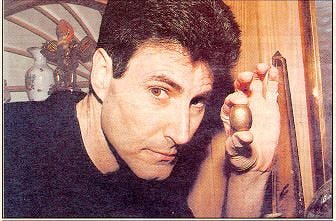
“One night he was lying in his bed in the Dakota building where he lived in New York and suddenly noticed an extremely bright light pouring in from around the edges of the bedroom door. It was so powerful, he thought it was someone aiming a searchlight through his apartment. He got up, crossed to the door and flung it open. The next thing he could remember was four thin-looking (bug-like) figures. He said that the figures came over to him as he just stood there. Two of them held his hands and the other two gently pushed his legs and he was gently guided into this tunnel of light. He was shown all of his life, just like watching a movie, and he told me it was the most outstandingly beautiful thing he’d ever seen.”
Lennon was adamant: “Something happened… Either I’ve forgotten, blocked it out, or they won’t let me remember. But after a while they weren’t there and I was just lying on the bed, next to Yoko, only I was on the covers.”
John also stated that something had been given to him by these four figures — a not quite egg-shaped ball of metal — very smooth and very heavy, about an inch or so wide. Lennon gave it to Geller, stating “It’s too weird for me. If it’s my ticket to another planet, I don’t want to go there.” (A position held in contrast to the description of him calling out to the cherry-on-top UFO to take him with them.)
Okay, that’s a lot. In addition to thinking he was abducted as a child, he was also visited in his home by creatures who told him his life story, then returned him to the bed he shared with Yoko Ono without her knowing he was gone. The ten minute sighting in New York. Oh, and the golden egg.
Geller does not make clear in his published statement whether he understood Lennon’s story to have taken place before or after his UFO sighting.
In His Own Sight
Here is a decent quality copy of the TV interview John Lennon did in the immediate aftermath of the incident. He certainly looks and sounds like a man who has very specific memories of an event that happened to him, and wants to communicate them to you.
Lennon Speaks
John Lennon never thought his sighting could be explained as a “government test plane” and had no doubt that the craft he saw was from another world.
Lennon’s thinking was always expansive so, of course, he did offer his opinion about Disclosure, the time when the world openly acknowledges the reality of unidentified aerial phenomena. He believed it would be a game-changer that would usher in revolution.
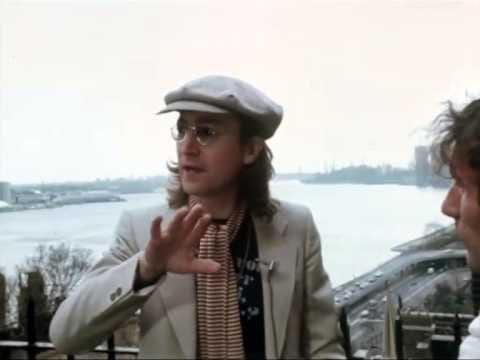
“If the masses started to accept UFOs, it would profoundly affect their attitudes towards life, politics, everything. It would threaten the status quo. Whenever people come to realize that there are larger considerations than their own petty little lives, they are ripe to make radical changes on a personal level, which would eventually lead to a political revolution in society as a whole.”
Pang has always maintained that the experience they shared on the roof changed Lennon. “He became even more fanatical, bringing up the subject all the time. John was always fascinated with the unusual,” explained Pang. “He was always caught up in his fate, his destiny.”
An 80-year-old John Lennon would see Disclosure as a defining issue and would be a keen observer of everything from the TTSA to the SSCI. He probably would have called Harry Reid up in the middle of the night to give him an earful for pulling back on his New York Times quote.
It’s a damn shame that John Lennon is not alive to see our world finally change.
Truth or Dare?
However you slice this, John Lennon and May Pang both testified consistently throughout their lives (Pang still actively maintains the story’s truth) about the unusual look of the object with the bulb-like running lights and the red cherry-on-top light. We know that its appearance was bizarre.
They testified that this object was huge and close. They saw a shimmer effect at the bottom of it, like heat waves in the summer.
One more thing.
It was completely silent.
For the sake of argument, even if you are skeptical, imagine what this would have felt like if it had happened to you. Then to watch such a creation work its way over the East River toward Brooklyn.
Such an event would be an astonishing, life-changing moment in the lives of anyone who experienced it. Many of us would want to tell people about it, but would keep it to ourselves for fear of ridicule. John Lennon was beyond that. He was about bearing witness.
Witness about what exactly? “It just reaffirmed our beliefs that there were other beings out there,” said Pang in an interview with ABC’s Good Morning America.
It is terribly difficult not to consider his life-long interest about UFOs and hold it against the veracity of his story. Abduction as a child, abduction from the bed he slept in with Yoko Ono, other sightings, the 52nd Street event. Either John Lennon had a continuing thing about claiming alien contact that didn’t happen, or, if it was happening that much, then his words on the subject might be important.
It does feel astonishing that there weren’t thousands of New Yorkers snapping photos and calling local police during this ten-minutes long in-your-face event. The omission is another uncomfortable fact.
So we are left to consider that something of this magnitude happened in New York City and extremely few people saw it or talked about it. Yet the number of people who could corroborate Lennon and Pang’s account is not zero. There appear to be stories told at the time about how other people who saw something similar had called it in to the police or the newspapers.
Where are these witnesses? Even now, those who saw this, should come forward. If police departments took calls from freaked out citizens, those logs appear to have never been checked. Local New York media with good access should get as many people on the record as is possible.
Otherwise, we are left with a difficult and unsolvable question.
How is it possible that a massive, slow-moving object, lit up like a child’s toy could linger on its journey over the East River and be largely unseen in a city of millions of people?
My heart wants to take John Lennon at his word. My gut tells me that it’s hard to rule out that what happened to him was more mind games than alien encounters.
If the phenomenon is truly paranormal more than extraterrestrial, the case presented by John Lennon and May Pang may be an important one to study. That would mean that they were telling the truth as they saw it, but that something besides physical reality is in play. Maybe religious visions are shared hallucinations. Maybe our universe really is stranger than we can imagine. Or, could it be that the phenomenon does not reveal itself to all because it is cloaking itself or because it is not a physical object, but something else?
That, by itself, would also be a mind-bending reality, if true.
On the issue of whether Lennon and Pang conspired to make up a story as a piece of performance art, we have to rule strongly in favor of their truthfulness. To listen to Lennon and Pang in their interviews is to feel strongly they believe what they are saying and are trying to get the details right for the record. This was no bed-in over at the Amsterdam Hilton.
This means, at the end of the day, we have to believe that they saw something that they interpreted as extraordinary. Was it a nuts-and-bolts flying saucer from outer space? It could possibly be related to an Intelligence-sponsored psychological test connected to Lennon’s immigration case. Or a manifestation of a spirit or a technology from an even more exotic source?
Within years, Disclosure will be underway in a significant and real way with the declassification of vast numbers of previously “lost” documents about the UFO phenomenon. When that process is engaged, we may find a few very enlightening memos about this event in New York City in 1974.
At the time, few really believed John Lennon when he complained he was being harassed by the Nixon Administration and the FBI. He was that angry political Beatle, after all. Later, as the Freedom of Information Act pried documents loose from the archives, it turns out that Lennon was telling the truth from the start.
It could happen again, this time with UFOs. Lennon made claims about his connections to the phenomenon. The Nixon Administration had him under surveillance. Did they see or learn anything and write a memo about it?
Gimme Some Truth.
Note: The narrative draws from diverse sources: biographies, blogs, articles, YouTube, interviews. Suggested attributions and corrections are welcome at brycezabel at stellproductions dot today. News analysis, commentary, #fairuse
